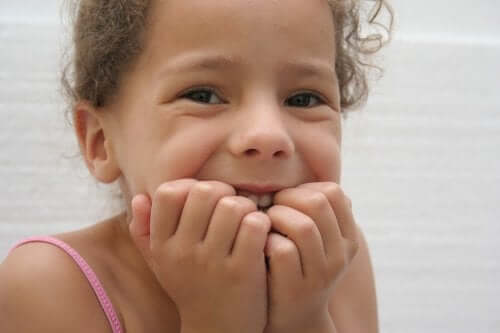Bad Habits and Tics in Children: What You Should Know


Reviewed and approved by the psychologist María Alejandra Castro Arbeláez
They twist their hair, bite their nails, suck their fingers, or touch their nose. These are some of the bad habits and tics in children that challenge many parents.
Can they be avoided? Do they cause any harm? How do you help them? These are the most common questions that arise after observing these repetitive behaviors in our children.
Habits known as mood disorders manifest in various ways. They can be transient, obsessive, or even turn into a bipolar disorder or a manic state when they present more serious variations. They tend to develop from the need to release emotions, anxiety, or frustration.
These behaviors are externalized in children between the ages of 3 and 5. They usually disappear with maturity, but in some cases, this doesn’t happen. On the contrary, they strengthen and interfere in the development of the infant.
Bad habits and tics in children
Habits are customs that we acquire unconsciously, they arise repeatedly and without control. They’re strengthened over time and, in many cases, it’s difficult to eradicate them since children use them to feel comfortable at times or to keep from getting bored in certain situations.
These habits occur when there’s irritability, anxiety, fatigue, or large states of tension or stress. They can cause bodily injuries such as dental malformations due to sucking a finger or deforming the fingernails by biting them too much. Kids also get teased for their bad habits; consequently, this affects social relations, especially in school.
To help eradicate a bad habit, it’s best to teach children to face their fears by giving them security and confidence in themselves. It’s important not to make them feel different so that they have no other cause for concern. Additionally, make it clear that they have parental support to overcome any difficulty.

How to help children overcome bad habits and tics
One of the most recommended activities in these cases is for the children to learn relaxation and breathing techniques. With them, they’re likely to discover what is producing the nervous habit or tic.
By detecting the cause in time, you can work on it and reduce the repetitive behavior. It usually disappears with the passing of time, but if this doesn’t happen, it’s advisable to go to a specialist.
Another effective alternative to help decrease these repetitive impulses is distraction through playing games.
For example, if the children suck their fingers a lot or bite their fingernails, you can implement a playful activity that requires having their hands busy at all times. This will prevent them from putting their hands in their mouth.
On the other hand, physical exercise is the best alternative to reduce stress. Riding a bike or swimming will help them clear their mind and create a new routine in their life. There won’t be any room for frustration because by being active, they won’t have negative thoughts that can lead them to feel anxious.
These behaviors are externalized in children between 3 and 5 years old. They usually disappear with maturity, but in some cases, they take hold.
Types of tics
Tics are repetitive movements or sounds that are almost uncontrollable. They have no conscious purpose and are often undisciplined. These compulsive gestures appear in highly stressful situations or when something new appears, which causes concern in a child’s mind. There are four types:
- Simple motor tics: These are the most common, such as blinking or winking of the eyes, head shaking, and moving the shoulders, arms, or legs. They’re usually transient and last from 1 to 12 months.
- Complex motor tics: Slow coordinated movements that involve more than one muscle group. Some examples are when children hit themselves, jumping or trampling, squatting, or spinning repeatedly.

- Simple vocal tics: They also occur frequently and include actions such as clearing the throat, snorting through the nose, or grunting.
- Complex vocal tics: Those that occur when children repeat the words that other people say (echolalia), repeat the same words again and again (palilalia), and when they say obscene words (coprolalia). These tics are chronic and last more than a year.
Origin and treatment of tics
This repetitive behavior is characteristic of shy, quiet, isolated, and very sensitive children. Tics help them to handle anxiety without noticing it and it’s more difficult to control because they do it unconsciously. In fact, trying to correct them can cause more anxiety and embarrassment for not being able to counteract it.
If we notice any bad habits or tics in children, the priority is to prevent these involuntary contractions from becoming an illness.
To do this, we must focus on strengthening their confidence and neutralizing adverse behavior. Moreover, monitor their evolution closely and if at any time we notice that there’s no progress, visit a specialist in the field as soon as possible.
They twist their hair, bite their nails, suck their fingers, or touch their nose. These are some of the bad habits and tics in children that challenge many parents.
Can they be avoided? Do they cause any harm? How do you help them? These are the most common questions that arise after observing these repetitive behaviors in our children.
Habits known as mood disorders manifest in various ways. They can be transient, obsessive, or even turn into a bipolar disorder or a manic state when they present more serious variations. They tend to develop from the need to release emotions, anxiety, or frustration.
These behaviors are externalized in children between the ages of 3 and 5. They usually disappear with maturity, but in some cases, this doesn’t happen. On the contrary, they strengthen and interfere in the development of the infant.
Bad habits and tics in children
Habits are customs that we acquire unconsciously, they arise repeatedly and without control. They’re strengthened over time and, in many cases, it’s difficult to eradicate them since children use them to feel comfortable at times or to keep from getting bored in certain situations.
These habits occur when there’s irritability, anxiety, fatigue, or large states of tension or stress. They can cause bodily injuries such as dental malformations due to sucking a finger or deforming the fingernails by biting them too much. Kids also get teased for their bad habits; consequently, this affects social relations, especially in school.
To help eradicate a bad habit, it’s best to teach children to face their fears by giving them security and confidence in themselves. It’s important not to make them feel different so that they have no other cause for concern. Additionally, make it clear that they have parental support to overcome any difficulty.

How to help children overcome bad habits and tics
One of the most recommended activities in these cases is for the children to learn relaxation and breathing techniques. With them, they’re likely to discover what is producing the nervous habit or tic.
By detecting the cause in time, you can work on it and reduce the repetitive behavior. It usually disappears with the passing of time, but if this doesn’t happen, it’s advisable to go to a specialist.
Another effective alternative to help decrease these repetitive impulses is distraction through playing games.
For example, if the children suck their fingers a lot or bite their fingernails, you can implement a playful activity that requires having their hands busy at all times. This will prevent them from putting their hands in their mouth.
On the other hand, physical exercise is the best alternative to reduce stress. Riding a bike or swimming will help them clear their mind and create a new routine in their life. There won’t be any room for frustration because by being active, they won’t have negative thoughts that can lead them to feel anxious.
These behaviors are externalized in children between 3 and 5 years old. They usually disappear with maturity, but in some cases, they take hold.
Types of tics
Tics are repetitive movements or sounds that are almost uncontrollable. They have no conscious purpose and are often undisciplined. These compulsive gestures appear in highly stressful situations or when something new appears, which causes concern in a child’s mind. There are four types:
- Simple motor tics: These are the most common, such as blinking or winking of the eyes, head shaking, and moving the shoulders, arms, or legs. They’re usually transient and last from 1 to 12 months.
- Complex motor tics: Slow coordinated movements that involve more than one muscle group. Some examples are when children hit themselves, jumping or trampling, squatting, or spinning repeatedly.

- Simple vocal tics: They also occur frequently and include actions such as clearing the throat, snorting through the nose, or grunting.
- Complex vocal tics: Those that occur when children repeat the words that other people say (echolalia), repeat the same words again and again (palilalia), and when they say obscene words (coprolalia). These tics are chronic and last more than a year.
Origin and treatment of tics
This repetitive behavior is characteristic of shy, quiet, isolated, and very sensitive children. Tics help them to handle anxiety without noticing it and it’s more difficult to control because they do it unconsciously. In fact, trying to correct them can cause more anxiety and embarrassment for not being able to counteract it.
If we notice any bad habits or tics in children, the priority is to prevent these involuntary contractions from becoming an illness.
To do this, we must focus on strengthening their confidence and neutralizing adverse behavior. Moreover, monitor their evolution closely and if at any time we notice that there’s no progress, visit a specialist in the field as soon as possible.
All cited sources were thoroughly reviewed by our team to ensure their quality, reliability, currency, and validity. The bibliography of this article was considered reliable and of academic or scientific accuracy.
- Chávez Vaca, V. A. (2019). Mecanismos biológicos del aprendizaje y el control neural en los periodos sensibles de desarrollo infantil. Sophia, Colección de Filosofía de la Educación, (26), 171-195. http://scielo.senescyt.gob.ec/scielo.php?pid=S1390-86262019000100171&script=sci_arttext
- Mendoza Morán, A. M. (2013). Hábitos nerviosos en el rendimiento escolar de los niños de 4 a 6 años de la escuela fiscal mixta matutina no. 121″ Dr. Abel Romero Castillo”(Bachelor’s thesis, Universidad de Guayaquil Facultad de Filosofía, Letras y Ciencias de la Educación). http://repositorio.ug.edu.ec/handle/redug/22187
- Prunes, J. (1979). Niños nerviosos. Maina, 32-33. https://www.raco.cat/index.php/Maina/article/download/104118/148092
- Ollendick, T. H. (1981). Self-monitoring and self-administered overcorrection: The modification of nervous tics in children. Behavior Modification, 5(1), 75-84. https://journals.sagepub.com/doi/abs/10.1177/014544558151006
- Ortiz Giraldo, B., & Blazicevich Carrillo, L. (2010). Tics: los trastornos del movimiento más frecuentes en los niños. Iatreia, 23(4), 386-399. http://www.scielo.org.co/scielo.php?script=sci_arttext&pid=S0121-07932010000400008
- Salcedo, M., Vásquez, R., & Calvo, M. (2011). Trastorno obsesivo compulsivo en niños y adolescentes. Revista colombiana de Psiquiatría, 40(1), 131-144. http://www.scielo.org.co/scielo.php?script=sci_arttext&pid=S0034-74502011000100011
- Suárez, A. D. (2008). Tics en pediatría. Pediatr Integral, 10, 989-994. https://www.pediatriaintegral.es/wp-content/uploads/2012/xvi10/05/795-801%20Tics.pdf
This text is provided for informational purposes only and does not replace consultation with a professional. If in doubt, consult your specialist.








